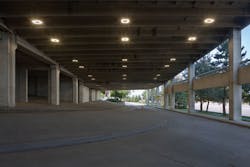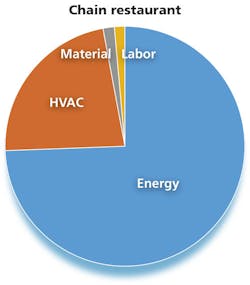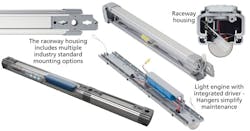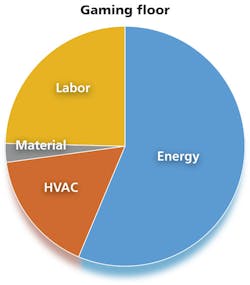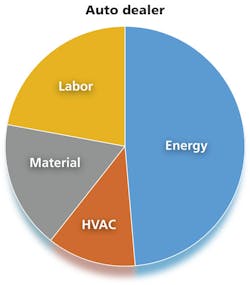Consider both long-term energy and maintenance savings and the impact of LED lighting projects on building market value to get a true look at the cost of major retrofits.
Don McDougall, general manager, Solid State Capital Services (SSCS)
The prime barrier to broader deployment of LED-based lighting remains high upfront costs despite the energy and maintenance savings that a retrofit can deliver over many years. There are a growing number of financing options for lighting projects, but still building owners struggle to justify major renovations. Lighting manufacturers, designers/specifiers, and building owners, however, must understand that solid-state lighting (SSL) retrofits are not akin to legacy lighting projects. High-quality LED lighting can deliver real capital improvement, measurable in building market value that can justify many projects.
Solid State Capital services (SSCS) completed a project for one of the largest property owners in Los Angeles County. The lighting retrofit that they completed cost them $60,000. The energy savings and other benefits gave this project a 30-month payback or return on investment (ROI). This client arranged to pay for the lighting and installation over time and so the project was effectively cash-flow positive the first year. The savings exceeded the amortized costs.
The above story is becoming relatively commonplace in the lighting industry as LED-based products improve in quality and drop in price. The most important benefit to this client was the increase in market value to the property. The savings in energy usage were so pronounced that the property’s market value was increased by $426,000.
The capital improvement view
All too often an LED lighting retrofit is seen as an expenditure or a maintenance issue. In fact, such a project is a capital improvement that increases the market value of the property. Like with any capital project, building owners should use quality products to ensure that they realize the highest return on investment (ROI). Ironically, spending more money upfront can be a good thing. Cheap products equal poor ROI.
Consider the previous example: The energy usage for the lighting has been cut by almost 80%. That energy reduction equates to $40,000 per year in reduced operating costs. What is $40,000 per year worth when you calculate the discounted cash flow of the property? Everyone calculates market values in their own way, based on their own concerns about risk and reward and the never-ending debate about cap and discount rates. This client calculated the increase in value at $426,000.
In any such projects, the building owner will have to consider local issues such as utility rates and local regulatory concerns. For example, in California, the California Public Utilities Commission (CPUC) recently approved an increase in utility rates and that data must be factored into longer-term savings. California is also faced with looking at higher than average energy costs to meet mandated green energy usage. Add this to the fact that the State is decommissioning one if not two major nuclear plants and you can see the reasons for the increased utility rates and the reason for sizeable increases in market value for renovated property.
Restaurant example
Let’s contemplate some other real examples that SSCS has worked on. A chain of 40 family-style restaurants completed a similar LED retrofit. While each store gained only a little more than $120,000 in value, the increase in value to the chain as a whole was in excess of $4.8 million. Fig. 1 depicts the breakdown in savings for the restaurant chain attributable to the lighting retrofit.
Single-property owners and lessees can also benefit. A warehouse distribution company in Hawaii installed a cutting-edge LED fixture from Tempo Industries that is a linear replacement for fluorescent lighting. The annual savings was $79,000 per year. Remember Hawaii has an energy rate of $0.37/kWh. But the increase in benefits had to be discounted as the lease only has another 10 years to go. That said, the initial benefit to this client is $650,000 in market value for the company, and an enhancement to the property to be used to barter when the lease comes up for renewal.
This last example is interesting in that the company assisting in setting up and selecting the new lighting chose the Tempo C7 CliP (Configurable Lighting Platform) system (Fig. 2). Tempo just announced new products in the CliP family that are designed to deliver L90 lifetime (90% of initial lumens) of 86,000 hours. That equates to ten years of continuous usage. Tempo said that the intent with product life is to match and even deliver longer-than-typical-interval building retrofits with normal usage patterns.
The point about the 86,000-hour rated life is how maintenance savings also impact building value. The ability to reduce the lighting maintenance cost effectively to zero for the next 20 years in an active work environment was one of the selling points in the Hawaii project and factored heavily into the building value.
Calculating market value
So how do you calculate the increase in value to a property due to the increase in cash flow from an LED lighting retrofit? There are two methods — one of them easy, the other more complex. SSCS prefers to run a DCF (Discounted Cash Flow) model on the increased income stream. This takes some work and some knowledge of the property owner’s plans for the property and aversion to risk.
The easy method is to simply take the annual savings and multiply it by a rate of return. There are a lot of fancy names for how you do this, but let’s just keep it simple. The number is generally between a factor of 6 and 10. So $10,000 in savings per year can mean $60,000 to $100,000 in increased market value.
You can argue that this is too simple an explanation or that the range is too broad. The fact is that most property owners have a number in their heads that they expect to use. We feel the DCF is more accurate, but sometimes you just need a place to start. Our thought is that anything that is a 10X multiple is probably too big an increase, but everyone calculates the value differently; when you remember that utility costs are not likely to drop anytime soon, the decision can be more complex than it first seems.
There are many other elements that can help justify an SSL retrofit and that can impact market value. For example, SSCS provides EPAct (Energy Policy Act) certifications, 1245/1250 depreciation calculations, abandonment cost tax accounting, and ROI assistance. We also work with clients’ utility providers to maximize the utility rebate. Maximizing such rebates can be more challenging that you might think.
Characterizing savings
We should also address determination of the savings in a project. Knowing that savings can create an increase in market value is great, but how do you project your savings? The savings come from several sources as we have discussed casually throughout the article, including the inclusion of the example charts for different business types.
Energy savings is sometimes the only calculation that is considered. Energy usage can be very important. But focusing solely on energy is a mistake. In some cases energy is not even the primary source of savings.
Nevertheless, let’s consider projection of energy savings. You simply take the usages of your current fixtures and compare those to the proposed new system. That comparison provides a realistic look at a one-year projection. Then we look historically at the increase in the cost of power for the location at hand. The historical look requires both a national and regional evaluation. For example, we have used a 4% inflation rate in cases. But the move away from coal and the mandated switch to green sources will move this number up — in some states to double digits. Where we can show support for a different inflation rate, we use those numbers.
Building owners should also consider controls. But you may not know what ya got or don’t have, and what you are going to get in the future. LEDs don’t suffer degradation from the integration of controls like fluorescents do where dimmed light levels don’t deliver commensurate energy savings. Building or facility owners must calculate their own numbers and double-check the savings touted by lighting vendors under consideration.
Moreover, the impact on controls varies greatly by application. For a parking garage with 24/7 usage, the percentage of savings can exceed 90% of the initial energy cost, relative to a non-LED system without controls.
The impact of LEDs on the HVAC system should also be figured in. Fluorescent lights give off more heat than you may recognize. Remove the fluorescents and you lose that extra heat.
How much can LEDs impact an HVAC bill? Optimally a building will realize 33% of the energy savings as a benefit. That is, for every watt you save in lighting you save an additional one-third of a watt in reduced HVAC draw. The best candidates for this full bonus are facilities that use a lot of energy for their AC. Some facilities may not have HVAC — for instance, a parking garage or open warehouse. In these cases there would be zero HVAC bonus savings. Still, building owners can calculate the HVAC energy bonus, and it is real and tangible. Don’t forget to include it in your calculation.
Maintenance savings
Last, we will address the complex topic of maintenance savings. LED lighting systems last longer than fluorescents and so owners save in two areas: the cost of the replacement lamps and the labor cost of replacing the bulbs and ballasts.
There is more to the cost of replacing bulbs than just these two components. Consider a casino where changing out a single lamp can cost $5,000 or more. The casino must add in the cost of bringing in a lift, cording off the area, readjusting security, and the loss of revenue as people stop playing slots to watch the exciting bulb replacement. Casinos track the revenue of each slot and game over time. The costs of replacing lamps are well documented. Fig. 3 depicts the casino savings breakdown. Some casinos will consider the $5,000 cost to be conservative. Many other businesses also suffer unexpectedly high maintenance costs.
Some businesses proactively manage the maintenance process. An upscale automotive dealership will use group re-lamping to control the costs. Dozens of cars need to be removed from the showroom and then brought back in, so the cost can be significant. A $3,000 charge per re-lamping is not unexpected and you may see this done more than twice per year with the lighting playing a critical role in highlighting the vehicles for customers. Fig. 4 depicts the savings breakdown for auto dealers.
Labor costs are also almost always an issue. Some companies will swear to you that they just use existing staff and that there are no real additional costs incurred except the lamps. One facilities director for a set of restaurants made this claim loudly in front of management, that there was no added cost for lighting maintenance, but he still absorbed thousands of dollars in overtime every single month. The director pointed out that the overtime was not lighting related. He pointed out that the crew handled the re-lamping during the day. That work, however, left cleanup tasks for which the restaurants paid overtime to cover.
Calculating the labor cost for a lamp replacement often involves asking questions about how labor is used and how management calculates their cost. One of our clients used contract union labor at $120 an hour to do their lamp replacements. For this client even routine lamp replacements were expensive. One site manager we worked with used the maintenance budget to cover attendance at conventions.
So for this portion of the savings there is no simple calculation that you can use; you need to understand how labor is used and how it works. You also have to spend the time with the property owner and facilities manager to get honest answers that you can use to prepare your calculations.
SSCS has reviewed multiple projects where the energy savings are only 50% of the total savings and less than that on a few rare exceptions — one being a paint booth for ships’ superstructures. The additive benefits of savings are impressive when you know where to look and how to add them up.
Still, remember that savings are more than a factor in determining ROI. The primary factor in justifying retrofits will remain the market value of buildings and other facilities. Each increase in savings adds to the market value of the property, and the total net worth of a project.

